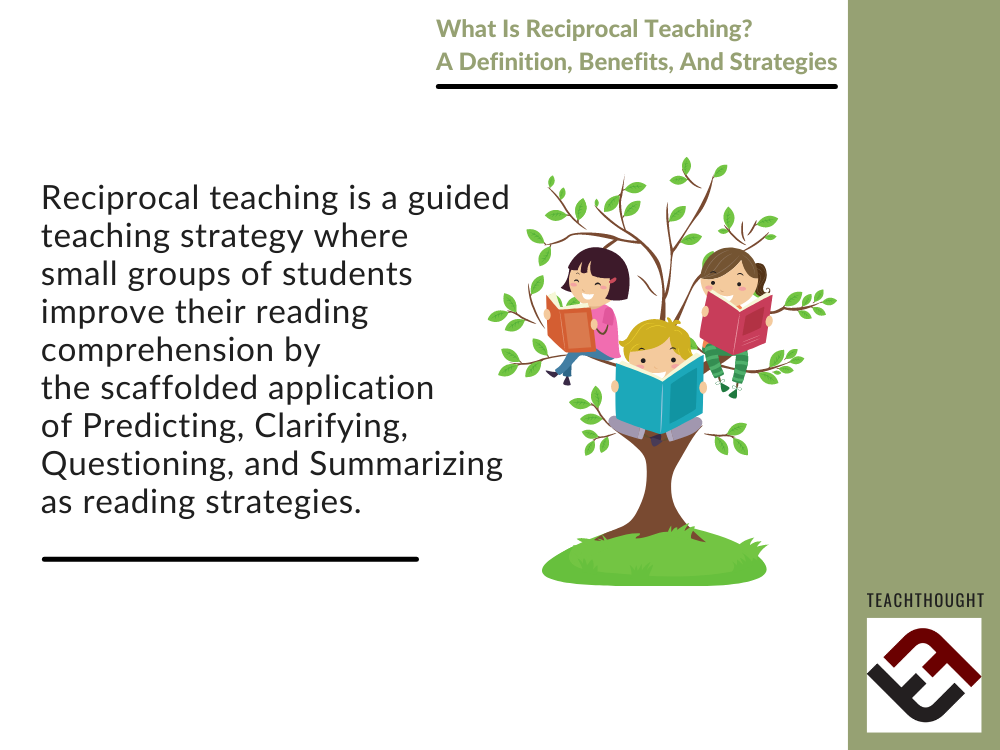What Is Reciprocal Teaching?
by Terry Heick
Reciprocal teaching is a guided teaching strategy where small groups of students improve their reading comprehension by the scaffolded application of Predicting, Clarifying, Questioning, and Summarizing as reading strategies (Palinscar & Brown, 1984).
In this way, it is a type of literature circle and uses a constructivist–and communal constructivism–approach to meaning-making where each student assumes the role of both teacher and learner within small groups.
What Are The Benefits Of Reciprocal Teaching?
The most obvious benefits of reciprocal teaching are improved comprehension and metacognition tendencies and skills. Further, student engagement is necessarily improved as long as the students are actively fulfilling their roles. Students can benefit from hearing one another’s perspective/interpretation of a text as well as practicing fulfilling a role within a group to realize an ongoing, collective effort.
Rather than viewing reading as a static activity, reading is a living, moving, fluid process that benefits from intentional sequences as mastery is developed, then from discussion and collaboration as that mastery is deepened.
The reciprocal teaching model has been used to improve comprehension for students who can decode but have difficulty comprehending text” (Lysynchuck, Pressley & Vye, 1990; Palinscar & Brown, 1984; 1985; Klingner & Vaughn, 1996, p.275)
Reciprocal teaching as a reading strategy engages students in an instructional activity in which the teacher:
1. Solves for the purpose of the reading activity and supports communication among students regarding their knowledge of the text.
2. Supports the reading group members to develop a shared understanding of what they have experienced through the reading experience.
3. Provides the students with helpful feedback to enhance the capacity of the group members to come to the text as a learned text.
The Definition Of Each Stage Of Reciprocal Teaching
Predicting: using existing knowledge to anticipate future events (in this case, in a text). While reading, students should self-monitor for the accuracy of their predictions. This metacognition can improve future predicting as well as comprehension of the text in question.
Clarifying: Identifying important, relevant, and/or confusing material from the text. Question stems can help here.
Question: Form relevant questions that both reflect a grasp of the text while guiding ongoing inquiry to improve understanding. Questions can often be formed using the ‘C & C’ method: what made you confused and what made you curious?
The power of ‘question generating’ comes from each point of view having something to contribute.
Summarizing: Reflect on reading (either in part or in whole)
Step 1
Scaffold instruction defining and modeling the use of these strategies–possibly days or even weeks before expecting students to use this ‘live’ in a lesson.
The teacher would, for example, read an excerpt aloud, recall the steps, and model the use of each (or summarizing one day, clarifying the next, etc., and then finally all at once).
Step 2
Group students in groups for four and assign each student a role based on one of the strategies (one summarizer, one clarifier, etc.)
Step 3
In their respective groups, students can read a short excerpt and each ‘perform’ their role (along with any other reading strategies like annotating a text or note-taking), starting with the predictor, who will predict what might come next while revisiting any previous predictions.
The questioner will form relevant, guiding questions to demonstrate understanding while guiding further inquiry while reading.
The clarifier will clarify crucial, compelling, or confusing parts of the text (which are often identified in the previous ‘questioning’ stage and, depending on the use, identify (or lead the group in identifying) ways to eliminate confusion and ‘understand.’
The summarizer will then reflect on both the original reading of the text as well as any important ‘teachable’ or ‘aha!” moments that occurred during the reciprocal teaching process.
Optional: In the next reading, students can switch roles within the same group or move between groups with the same role or, again, the next role in the sequence. This continues until the reading is finished (either during the same class or, in the case of a longer text, when the reading is complete over the span of several days or weeks).
What Is The Teacher’s Role In The Process?
The role of the teacher in reciprocal teaching is to use the gradual release of responsibility model to support, coach, and guide students until they can use the sequence independently–both in groups and eventually on their own.
It is critical that students are given supportive and personalized feedback by the teacher during their reading and reflecting on the text. In this way, reciprocal teaching is characterized by the ongoing modeling and dialogue between the teacher and the students (Carter, 1997).
This is accomplished in large part by using think-alouds to emphasize the definition of each role, its relative value in improving comprehension, and its actual use in meaning-making during the reading of a text (Klingner and Vaughn, 1996).
Through this active process of meaning-making, younger readers will begin to see that reading is a process of first decoding, then ongoing metacognition to guide comprehension over the course of a text. (Palinscar & Brown, 1984, Allen, 2003, p.324).

